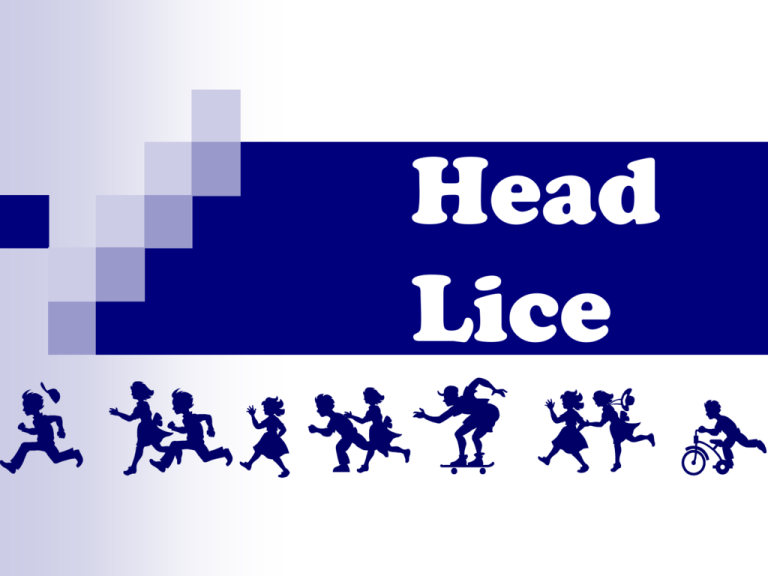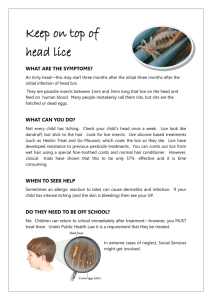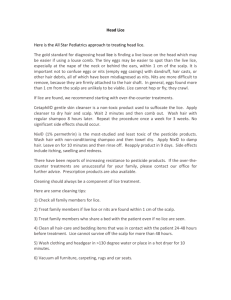Head Lice PowerPoint Presentation
advertisement

Head Lice What are Head Lice? Insects that live and reproduce on your head Head lice feed on blood from your scalp Head Lice are a common nuisance, and are not considered a health hazard Who can get Head Lice? Anyone who has close head-to-head contact with someone who has head lice More common among preschool and elementary school-aged children and their families Personal hygiene or cleanliness in the home or school has nothing to do with getting head lice Head lice cannot live on pets or animals, only on humans. Contracting Head Lice Head lice crawl quickly from head to head when in close contact Cannot fly, jump, or hop Head lice can be transferred when personal objects are shared - e.g. combs, brushes, hats Recognizing Head Lice Tickling feeling on scalp Itchy scalp Feeling of something moving in the hair Irritability Sores on head from scratching Presence of nits, nymphs, and/or adult head lice What do they look like? Adult head lice Tiny wingless brown insects; size of a sesame seed Live for about 20 days If a louse crawls off of a head, it dies within 2 days What do they look like? Nymphs Are baby head lice Smaller than adult head lice Mature in about 1 week Nits (eggs) Tiny specks; about the size of a knot in thread Firmly attached to the hair close to the scalp Nits are usually found on the hair behind the ears, at the back of the neck, and above the forehead. Do not mistake for dandruff, which can be easily blown off. Treating Head Lice Ask your pharmacist for a recommended treatment product Only treat when nits or live head lice are present – head lice products do not prevent head lice. Follow product instructions carefully to avoid re-infestation The products kill the head lice and many eggs, but for most products a second treatment is needed 7 to 10 days after the first treatment to kill any newly-hatched lice before they mature. Treating Head Lice 1. Before applying treatment, shampoo child’s hair over a sink with regular shampoo – do not use conditioner or combination shampoo/conditioner - many products require you to damp-dry the hair with a towel or blow dryer. 2. Wear plastic or rubber gloves to avoid unnecessary exposure to treatment product. - wrap a towel tightly over the child’s eyes to protect them Treating Head Lice 3. Apply the head lice product according to product directions. - timing is important - if the product is rinsed off too soon, head lice and nits may not be killed. If left on too long, there is unneeded product exposure. 4. Rinse child’s hair under tap, not in shower or bath, to minimize product exposure on the rest of the body. - wash your hands well after using product - do not re-wash hair for several days after treatment Treating Head Lice Many products require a second treatment 7 to 10 days later to kill any newly-hatched lice. If you see active lice 8- 12 hours after treatment, contact your healthcare provider or pharmacist. A different treatment product may be needed. Treating Head Lice Talk to your healthcare provider: If a child is under the age of 2 If you are pregnant or breastfeeding If a person has a seizure disorder If a person has broken or infected skin If lice are on eyebrows, eyelashes or facial hair General Information on Head Lice Products Follow the directions Timing is important Do not mix products Rinse child’s hair under tap Products should not be used near the eyes, nose, or mouth Wear plastic or rubber gloves Wash your hands after using product Store products away from children Do not apply to open or infected skin Treating Head Lice All nits should be removed after treating with product Head lice products are not 100 % effective Removing nits: will reduce hatching of eggs that were not killed with treatment will allow you to notice if a new infestation occurs Treating Head Lice To remove nits: Part and lift hair to check for nits or lice Work under a good light (window or lamp) Live lice can be removed with scotch tape wrapped around your finger Treating Head Lice To remove nits Use your thumbnail/first finger to grab the nit and slide it off the hair shaft. A fine- tooth nit comb may also be useful, but are not effective with fine hair. Place nits in a plastic bag, seal and put in garbage Take frequent breaks, especially with young children. Check and remove nits daily for 2-3 weeks. Treating Head Lice Avoid home remedies – no scientific proof of effectiveness Do not use flea control products, turpentine, paint thinner, etc. If your child has head lice, tell the school/child care facility and child’s close contacts immediately to prevent further spread Housecleaning Wash in hot, soapy water: Headwear, combs, brushes, pillowcases, towels, bedsheets Items that cannot be washed should be stored in a sealed plastic bag for 2 weeks Excessive housecleaning is unnecessary, but vacuum surfaces where heads have rested Sofas, car seats, helmets NEVER use insecticide sprays Controlling the spread of Head Lice Discourage head-to-head contact and sharing of hats, scarves, brushes, combs and headwear Check heads of all people in close contact Treat all family members with head lice at the same time Check young school-aged children weekly for head lice; more often if there is an outbreak If head lice continue to return, call your healthcare provider Recommended websites: Perth District Health Unit Huron County Health Unit www.huronhealthunit.com Center for Disease Control and Prevention www.pdhu.on.ca www.cdc.gov/ Canadian Paediatric Society www.cps.ca www.caringforkids.cps.ca Please note that information about head lice varies among sources For further information, contact… Health Line 519-271-7600 ext 267 or toll-free 1-877-271-7348 ext 267 www.pdhu.on.ca



